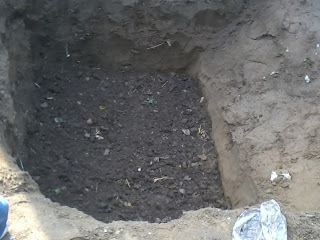Our greatest weakness lies in giving up. The most certain way to succeed is always to try just one more time.
-Thomas A. Edison
The work began on 4th February, 2011. A pit of 4.5'x4.5'x4.5' dimension was made in the research plot of our department of Biological Sciences. The pit was made rectangular. Our Nature Conservers Team participated in this task very enthusiastically. After digging the pit a plastic sheet was placed over that pit and was tightened with the help of bamboo poles. Four holes were made at the four corners of the pit for water to escape and proper aeration. Temperature was recorded as 20 degree Celsius.
 |
| The pit |
|
 |
| Pit-enlarged |
|
After making the pit a layer of cow dung was spread over the pit as you can see from the picture below.
 |
| Layer of cow dung |
|
After that dried leaves and husk were added over the layer of cow dung.Temperature was recorded to be 22 degree Celsius.
 |
| Pit with leaves and vegetable peelings |
 |
| Pit with dry Leaves and Husk |
|
The vegetable matter and the dry leaves as well as the husk were mixed together without disturbing the lower layer of the cow dung. Then the pit was watered so that the heat may get lost as well as the microbes may get a chance to increase their activity and the waste matter may undergo decomposition. Watering is a very important part of vermiculture.
 |
| Lets Work Together |
|
|
 |
| Watering the pit |
|
The temperature was again measured and it was 23 degree Celsius. the pit was left for 3 days so that the microbial activity can take place and water was sprinkled every day over the waste material. After 3 days a layer of cow dung was spread over the rotten content.
 |
| Final layer of cow dung |
When the water got absorbed earthworms belonging to the genus Eisenia foetida were released over the pit. just above the layer of cow dung a very thin layer of soil was also spread in order to provide a natural environment for the earthworms. The earthworms were brought from an organic farm located near our University.
 |
| Earthworms over cow dung and soil layer |
A layer of jaggery solution was also added. jaggery solution helps the earthworms to grow well fast.
Eisenia foetida
 |
| Eisenia foetida |
Also known as Red earthworms. Earthworms are the members of phylum Annelida, also known as Farmer's Friends as they convert the natural waster matter into organic manure rich in nutrients that are beneficial for the growth of the plants.The body is divided into a large number of segments. The first segment of body is known as peristomium followed by prostomium. Mouth is present at the tip of the body and the terminal most opening on the body is anus. The 14-16th segment being occupied by clitellum which can be easily identified as a dark reddish band.The clitellum secretes albumen for the formation of cocoon. The male genital pores are present on the 18th segment while female genital pores are present on 14th segment.The overall length of body is 3-10 cm and they weigh about 0.4-0.6g. They attain maturity in about 50-55 days.
 |
| Red Earthworm |
|
After releasing the earthworms the pit was covered with a jute bag and was allowed to dry.
 |
| Pit after release of earthworms |
|
|
|
The earthworms entered the layer of soil as well as cow dung. The pit was then covered with a jute bag and left to dry. everyday the temperature was measured which came around 23-24 degree Celsius. Water was sprinkled everyday for maintaining the moisture content as well as aeration of the pit.
 |
| The changing texture of pit |
|
The earthworms appeared after some days on the upper layer when it was scrapped a little. They were healthy and had acquired a good length as well as body weight. Water was sprinkled each and every day and temperature was recorded.
 |
| Earthworm |
|
 |
| Earthworm on finger |




















No comments:
Post a Comment